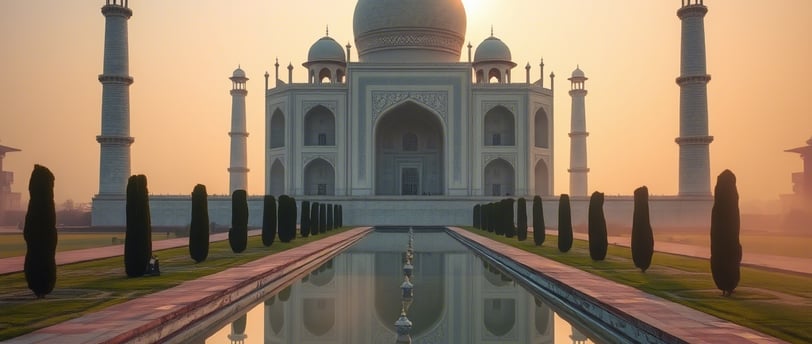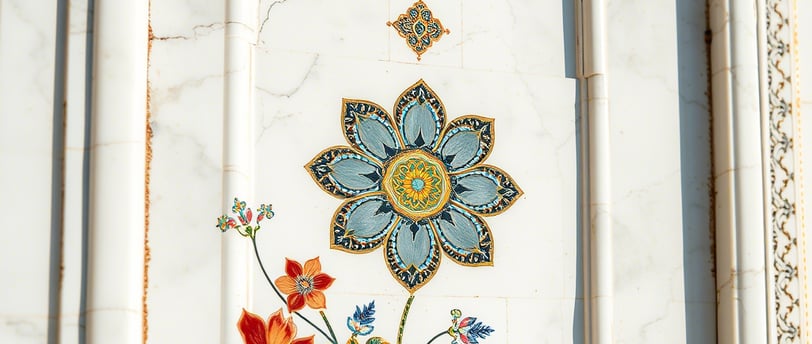Taj Mahal: History, Architecture, and Timeless Beauty
A Masterpiece of Mughal Architecture
TSI BLOG
TSI Architects & Engineers
5/28/20254 min read


The Taj Mahal, located in Agra, India, is one of the most iconic and breathtaking examples of Mughal architecture. Built by Emperor Shah Jahan in memory of his beloved wife Mumtaz Mahal, this mausoleum stands as a testament to love and architectural brilliance. Its grandeur, symmetry, and intricate detailing have captivated visitors for centuries, making it a UNESCO World Heritage Site and one of the New Seven Wonders of the World.
Historical Background of the Taj Mahal
Commissioned in 1632 and completed over a span of approximately 20 years, the Taj Mahal was constructed under the supervision of Ustad Ahmad Lahauri, often regarded as the chief architect. The project involved thousands of artisans, craftsmen, and laborers from across India and Central Asia. The white marble used in its construction was sourced from Makrana in Rajasthan, while precious and semi-precious stones for inlay work were brought from various parts of the world.
The historical context of the Taj Mahal is deeply rooted in Mughal history. After the death of Mumtaz Mahal during childbirth in 1631, Shah Jahan was devastated. Determined to immortalize her memory, he envisioned a monument that would symbolize eternal love and reflect the pinnacle of Mughal artistry. This vision culminated in the creation of the Taj Mahal, which not only served as a mausoleum but also as a statement of imperial power and devotion.
Architectural Style and Design Elements
The Taj Mahal exemplifies the fusion of Persian, Islamic, and Indian architectural styles. Its design follows the classical principles of Mughal architecture, characterized by symmetrical layouts, large domes, minarets, and elaborate ornamentation. The central dome, flanked by four smaller chhatris (domed kiosks), rises majestically to a height of about 73 meters (240 feet). The use of white marble enhances the building’s ethereal beauty, especially when illuminated by natural sunlight or moonlight.
One of the most striking features of the Taj Mahal is its perfect symmetry. The main structure is mirrored on either side by identical buildings—one serving as a mosque and the other as a guest house. These structures are made of red sandstone, providing a stunning contrast to the white marble of the mausoleum. The entire complex is laid out in a charbagh (four-part) garden, inspired by Persian gardens, symbolizing the paradise described in the Quran.


The calligraphic inscriptions adorning the walls of the Taj Mahal are another remarkable feature. Verses from the Quran, written in elegant Thuluth script, are inlaid using black marble. These inscriptions appear larger near the top due to an optical illusion technique known as "trompe l'œil," ensuring they maintain proportion when viewed from below.
Ornamental Details and Inlay Work
The decorative elements of the Taj Mahal are nothing short of extraordinary. Pietra dura, a technique involving the inlay of semi-precious stones into marble, is extensively used throughout the structure. Flowers, vines, and geometric patterns are meticulously crafted using jasper, jade, turquoise, lapis lazuli, and amethyst. Each inlay is hand-cut and polished to perfection, creating a seamless blend of color and texture.
The interior of the Taj Mahal is equally opulent. While the cenotaphs of Mumtaz Mahal and Shah Jahan are housed within the central chamber, the actual graves lie in a quiet, restricted crypt below. The chamber is adorned with intricate carvings, gilded inscriptions, and delicate lattice screens that filter soft light into the space. Every inch of the interior reflects the grandeur and craftsmanship of Mughal artisans.
The Role of Gardens and Water Features
The Taj Mahal's architectural splendor is further enhanced by its meticulously planned gardens and water features. The charbagh garden, divided into quadrants by walkways and water channels, represents the four rivers of paradise mentioned in Islamic tradition. These channels, once filled with scented water, not only added to the visual appeal but also helped regulate temperature through evaporative cooling.
At the center of the garden lies a raised marble platform where the mausoleum stands. A long reflecting pool runs along the central axis, mirroring the Taj Mahal and creating a sense of infinite beauty. During full moon nights, the reflection of the white marble structure in the pool transforms the entire scene into a dreamlike vision.
Surrounding the main structure are cypress trees, symbolizing death, and fruit-bearing trees, representing life. This juxtaposition reinforces the theme of eternity that permeates the entire complex. The careful placement of fountains, pavilions, and pathways ensures a harmonious balance between architecture and nature.
The Influence of Persian and Indian Elements
While the Taj Mahal is quintessentially Mughal, its design incorporates influences from both Persian and Indian architectural traditions. The bulbous dome with a lotus finial is reminiscent of Persian monuments like the Timurid tombs in Samarkand. However, the use of red sandstone in the subsidiary structures and gateways draws inspiration from indigenous Rajput architecture.
The integration of Hindu motifs, such as bell-shaped brackets and chhatris, adds a unique Indian touch to the overall design. The interplay between these diverse cultural elements results in a structure that is both globally inspired and distinctly Indian. The Taj Mahal thus serves as a bridge between different artistic traditions, embodying the cosmopolitan spirit of the Mughal Empire.
Preservation and Challenges
Over the centuries, the Taj Mahal has faced numerous challenges, including environmental pollution, weathering, and structural stress. The white marble has yellowed due to industrial emissions and acid rain, prompting conservation efforts by the Archaeological Survey of India (ASI) and international experts. Measures such as restricting vehicular traffic near the site, cleaning the marble with mud packs, and monitoring air quality have been implemented to preserve its pristine condition.
Despite these challenges, the Taj Mahal continues to inspire awe and admiration. It remains one of the most visited tourist attractions in the world, drawing millions of visitors annually. Its enduring legacy lies not only in its physical beauty but also in the emotions it evokes—love, loss, devotion, and the timeless pursuit of perfection.
The Taj Mahal is more than just a monument; it is a masterpiece that encapsulates the soul of Mughal architecture and the depth of human emotion. From its symmetrical layout and ornate inlay work to its lush gardens and spiritual symbolism, every aspect of the Taj Mahal speaks of unparalleled craftsmanship and artistic vision. As we marvel at its beauty, we are reminded of the enduring power of love and the ability of architecture to transcend time, culture, and geography.
Whether seen at dawn, dusk, or under the glow of the moon, the Taj Mahal continues to enchant all who behold it. It stands not only as a tribute to a queen but also as a beacon of artistic excellence that will inspire generations to come.
TSI Architects & Engineers
© 2024. All rights reserved.
